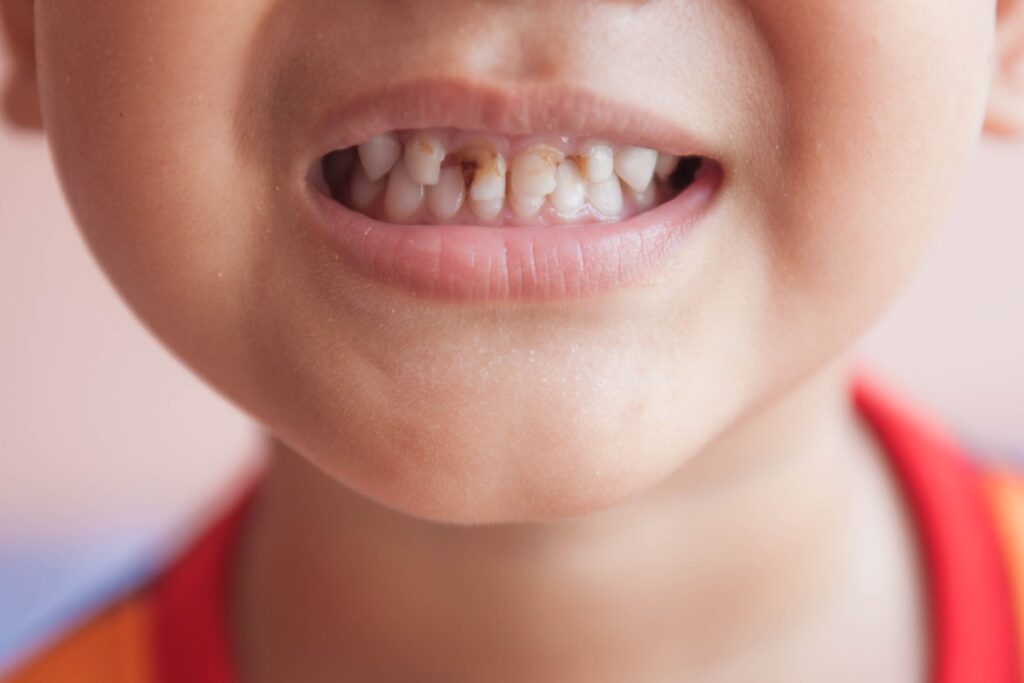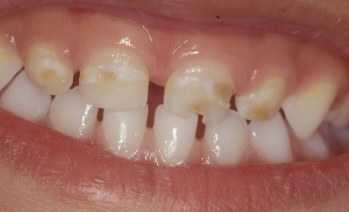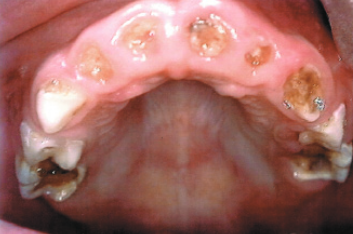Early Childhood Caries

As soon as a child has a tooth, that child can get cavities. But just because something is possible doesn’t mean it’s likely, right? Unfortunately, tooth decay in very young children is far more common than you might think. According to the most recent data from the National Institute of Dental and Craniofacial Research, approximately 28% of American children between the ages of 2 and 5 have cavities.
To make matters worse, tooth decay in very young children is especially aggressive. When left untreated, it can rapidly destroy entire teeth and can lead to infections that become medical emergencies. This is especially problematic because tooth decay often does go untreated in very young children. In fact, one study found that approximately 52% of children aged 3.5 years or younger who were brought to a U.S. children’s hospital for caries-related emergencies had their first contact with a dentist in the emergency room.
Help protect your child against early childhood caries by learning more about the disease and what you can do to prevent it!
What Is Early Childhood Caries?
Early childhood caries (“ECC”) refers to tooth decay in children under the age of six. A child under the age of six has early childhood caries if the child (1) currently has a decayed tooth, (2) has lost a tooth as a result of tooth decay, or (3) has had a cavity filled.
What Does Tooth Decay Look Like in Babies, Toddlers and Preschoolers?
In its early stages, tooth decay typically manifests itself as small white or brown spots on children’s teeth. As the disease progresses, the discolored spots will turn into small holes (cavities). If not treated, the disease can eventually destroy most or all of the affected tooth’s crown (i.e., the visible portion of the tooth), leaving the child with only a small stump above the gumline.


What Is the Difference Between Early Childhood Caries and Baby Bottle Tooth Decay?
The only difference is the name. In the past, early childhood caries was often referred to as “baby bottle tooth decay”, “nursing caries” or “nursing bottle caries” due to associations that have been found between tooth decay in young children and certain nursing and bottle-feeding practices. However, several decades ago, the American Academy of Pediatric Dentistry recognized that the causes of early childhood caries are more complex than simply childhood feeding practices. As a result, it adopted the term “early childhood caries” to better reflect the multifactorial causes of tooth decay in very young children.
How Are Cavities in Baby Teeth Treated?
Proper treatment for early childhood caries depends on how far the disease has progressed. A minor cavity in a child’s tooth may be treatable with a simple dental filling, whereas treating a deep cavity may require pediatric pulp therapy or even baby tooth extraction.
If a child’s tooth is still in the early stages of decay and has not yet become cavitated (i.e., has not yet progressed to the point of an actual cavity), it is sometimes possible to treat the decay without the use of invasive procedures. When this is the case, your child’s pediatric dentist will work with you and your child to develop an appropriate tooth decay treatment plan, which may include preventative measures such as fluoride varnish treatments, dietary modifications, and improved oral hygiene practices.
If invasive procedures are necessary, keep in mind that, in many cases, it can be difficult or impossible to safely perform such cavity treatments on babies and toddlers without the use of pediatric dental sedation. In certain circumstances, silver diamine fluoride may be used to temporarily treat tooth decay until the child is older and better able to tolerate invasive treatment options without sedation.
What Happens If You Don’t Treat Early Childhood Caries?
How big of a deal is it if a baby, toddler or preschooler gets cavities? Since the child’s primary (“baby”) teeth are going to fall out anyway, is it really even necessary to treat cavities in very young children?
The answer is that, left untreated, cavities in baby teeth can become an extremely big deal. Early childhood caries spreads more rapidly than tooth decay in adult teeth. Babies, toddlers and preschoolers with untreated cavities can quickly develop various short- and long-term health issues, including the following:
Pain. A cavity is a hole that begins forming in the tooth’s outermost layer (the dental enamel) and progresses inward toward the center of the tooth. Once the cavity has worked its way through the dental enamel layer, the tooth’s second layer (dentin) becomes exposed, which can lead to tooth sensitivity and pain. Because the layer of dental enamel on primary teeth is thinner than that on permanent teeth, cavities in baby teeth can become painful relatively quickly.
As the cavity continues to progress, the bacterial infection can spread to the nerve-filled center of the tooth (the dental pulp), which can result in pain so severe that it prevents the child from sleeping properly.
Premature tooth loss. Early childhood caries is an especially aggressive form of tooth decay that can destroy a child’s teeth over a relatively short amount of time. More frequently than you might expect, we see toddlers and preschoolers with cavities that have damaged their teeth so badly that only shards or stumps of teeth remain. In these cases, we typically have no choice but to remove the shard or stump because there simply is not enough tooth structure remaining to perform a dental restoration. Removal of a baby tooth may also be indicated in early childhood caries cases where the child’s cavity has reached the dental pulp and caused a severe infection.
Losing a baby tooth too soon can cause long-term dental issues, including crooked teeth and bite problems. Additionally, baby teeth that are lost prematurely cannot be replaced with prosthetic teeth, since inserting a prosthetic tooth would interfere with the proper development of the replacement permanent tooth. This means that, when a toddler loses teeth prematurely due to cavities, the toddler will be missing teeth for years until the replacement permanent teeth come in. This can potentially lead to difficulties eating, difficulties speaking clearly and aesthetic concerns.
Serious infections. As described above, cavities can lead to serious and extremely painful infections of a child’s dental pulp. In some cases, when left untreated, these infections spread to other parts of the child’s body. In extreme cases, untreated tooth decay can even result in life-threatening infections like brain abscesses and Ludwig’s Angina.
How to Prevent Early Childhood Caries
Looking for more information about what causes early childhood caries and how to prevent it? Check out our article on causes of cavities in children for tips on how you can help prevent your baby or child from getting cavities.
Early Childhood Caries Prevention and Treatment in Hurst, TX
Hurst Pediatric Dentistry’s Dr. Lin is a board-certified pediatric dentist who is specially trained not only to treat early childhood caries, but also to assess young children’s risk of developing tooth decay and to provide parents with the education and guidance they need to help prevent it. Call us today at (817) 510-6400 to schedule a cavity risk assessment for your baby or toddler.
Hurst Pediatric Dentistry is located in Hurst, TX, and serves pediatric patients from Hurst, Euless, Bedford, Colleyville, North Richland Hills, Fort Worth, Arlington and the surrounding area.
This article is intended to provide general information about oral health topics. It should not be used to diagnose or treat any disease or as a substitute for the advice of a healthcare professional who is fully aware of and familiar with the specifics of your case. Always seek the advice of your dentist or other qualified healthcare provider with any questions you may have regarding a medical condition or treatment.
MEDICALLY REVIEWED BY:
Dr. Jin Lin

Dr. Jin Lin is a board-certified pediatric dentist with a passion for helping children achieve healthier, more beautiful smiles. He earned his Bachelor of Science degree from Cornell University and his Doctor of Dental Medicine (D.M.D.) degree from the Harvard School of Dental Medicine. After graduating cum laude from dental school, he completed his post-doctoral pediatric dentistry training at Boston Children’s Hospital and the Harvard School of Dental Medicine, where he served as chief resident and worked with children with a wide variety of special medical and dental needs, including children with rare syndromes.

